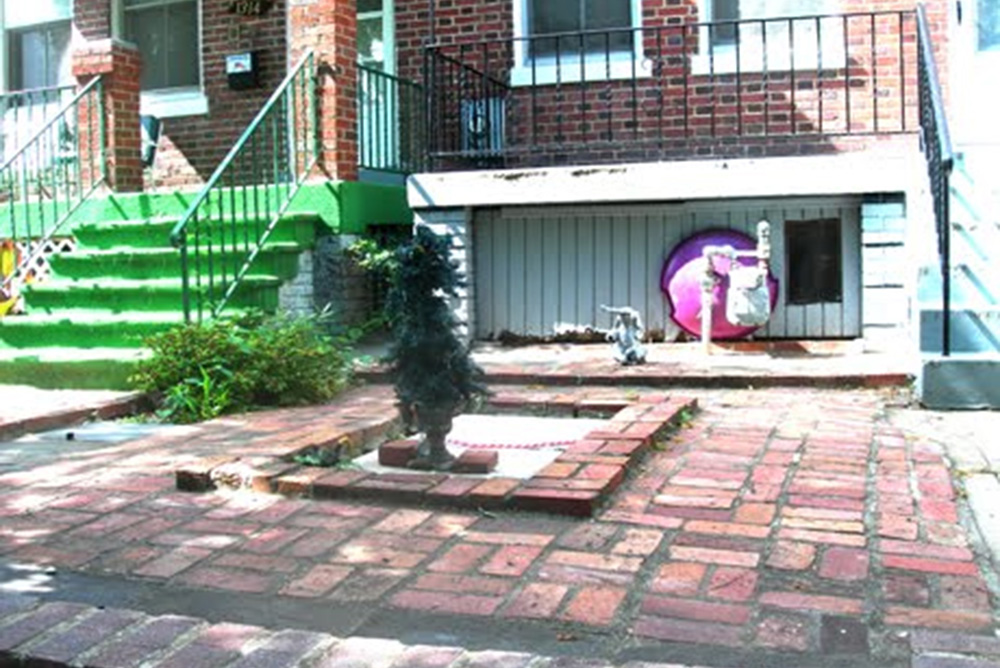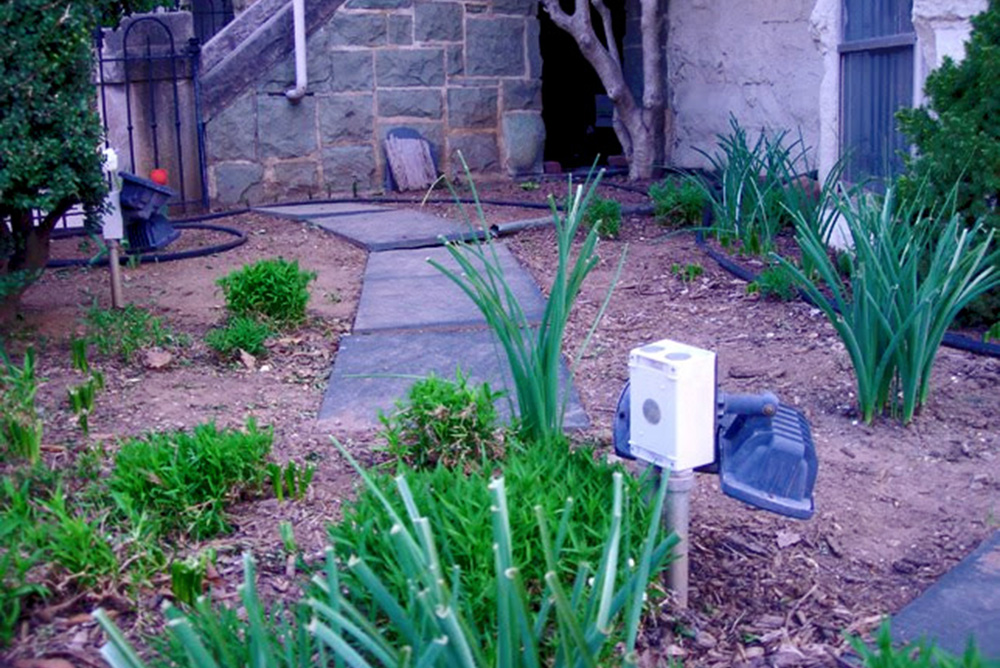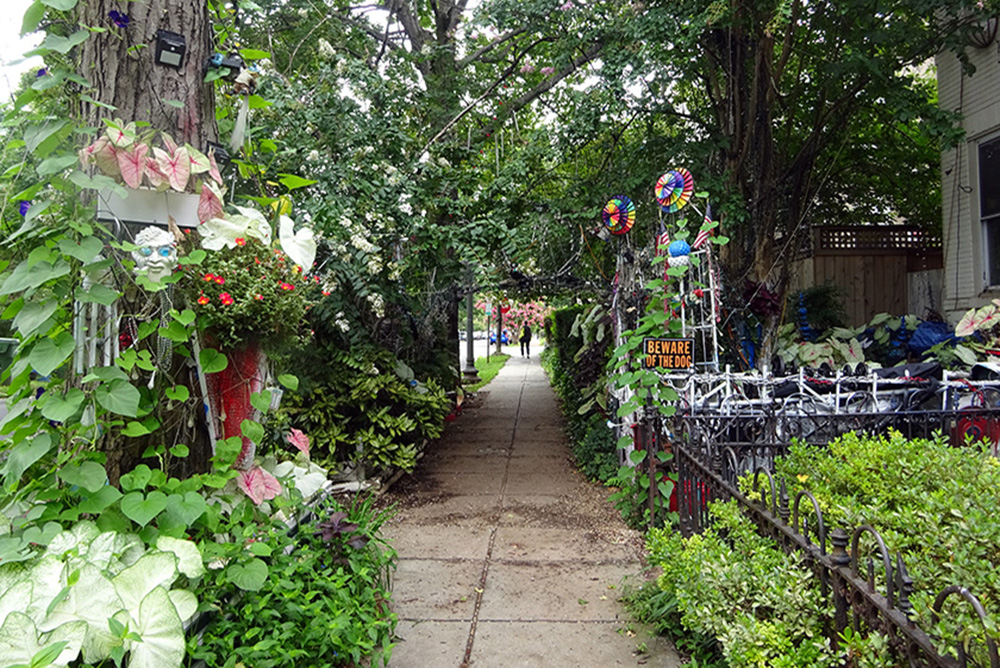WE’RE HEADING INTO late summer, and everything that’s going to be in bloom either is or was or is about to be.
Among those that are not are the gardens that give one (meaning me) pause to think: What on earth were they thinking?
I featured one such some months ago; here are a few more that tempt one (me again) to bang on the doors, or lurk about waiting for the inhabitants to emerge, and then say, in wide-eyed, startled and ever so innocently curious fashion: This is quite a sight, what is your theme?
But one is fearful, very fearful.
For instance there is . . . .
The Penitentiary

This house must harbor people who do not like to garden, do not like outdoor work at all, do not like . . . the color green? / Photo by Stephanie Cavanaugh.
The less said about this garden the better, but I will try. A fringe of green (which qualifies it as a garden) makes a valiant effort along the perimeters of a chain-link fence that defines perhaps the least welcoming entry of any home on DC’s Capitol Hill.
Perhaps the residents consider it a carefree patio. Swept free of debris and leaf (difficult to do considering the trees that line the broad avenue it faces) and so neatly bricked from steps to stoop that chairs and tables would sit perfectly steady, with no need of a matchbook or wadded gum to prop uneven legs and keep the coffee from sloshing. That is, if there were furniture, which there never is.
The thought blossoms: What anger led to this? Consider the effort to upend and flatten the soil, the tedium of laying brick against brick against brick. This cannot be a happy place.
The house is occupied, the gate is ajar today. Someone is breathing behind the tinny slam of the storm door.
Shudder.
A Double Whammy

Hard to know what the concept here once was. / Photo by Stephanie Cavanaugh.
Where does one start with this?
Clearly, someone had a concept. A patio? Perhaps a plaza? There’s a centerpiece of raised bricks, a surround for a dramatic focal point—in this case an artificial shrub. I cannot tell what material it is—it’s kind of papery, with a little sheen. But its importance to the tableau is indicated by the brick pedestal on which it sits and is underscored by the gaily striped chain that fends off prospective thieves. Slightly northeast of the urn in which the “plant” is displayed is a gray plastic elephant sitting back on its haunches. It appears to be braying. This is possibly the home of Republicans.
I like the pink ball pushed back under the front porch. In design circles this is known as a group of three and provides an imbalanced balance, you see. No? Perhaps a future column will deal with it.
In one of life’s happy little coincidences, the next-door neighbors have installed lush green plastic carpeting up their front steps. The result being that if you’re standing in front of these two houses, you just don’t know what to look away from first.
Is It Coming . . . or Going?

That lonely red tulip in the rear left proves that someone once thought of this as a garden . . . with flowers. / Photo by Stephanie Cavanaugh.
One day, some months back, I was loitering on a corner waiting for a friend and, looking without looking, I realized that my eyeballs were being assaulted by a dirt patch that obviously, at some point, had been attended to—and at some point later was not.
Notice the sad red tulip standing singularly in the far left corner. Follow the flagstone walk to where the daffodils, their foliage mingling with some valiant weeds, have given up blooming. If you’ve ever raised daffodils you know that’s nearly as impossible as eradicating dandelions (though why you’d want to eradicate the latter, I don’t know. Cheery harbingers of spring, I say! And then they turn into that fuzzy fairy fluff that you make a wish and blow on. Wow. I suddenly realized, even dandelions don’t want to live here).
And that white box sticking up from the dirt in the foreground sure is . . . white. Well, dirty white. Such a tastefully subdued shade of white. Yes?
Meanwhile, the black rope that is coiling snakelike around the border appears to be a vestigial watering system. At least I hope it is.
There are lights installed should you wish to have a clear view at night.
Putting the Fun in Funerals

One wonders what is *not* in this “garden display.” / Photo by Stephanie Cavanaugh.
Then there is a complete mystery that I’ve saved as the grand finale, since it appears to feature a bier, which it might well be.
This arrangement was begun a decade or so ago, perhaps in celebration of Saturnalia, since it materialized just before Christmas but is hardly jolly. A street tree in front of a typical row house, just a few blocks from mine, was draped in a jumbled collection of multi-colored flashing lights that appeared to have been dropped from a great height and left where they landed, some coiled, some stretched.
The holidays came and went, but the lights remained. A rectangular construction was added, surrounding the tree box—four horizontal metal poles with ball finials atop each end post. Just the sort of construction one would expect to prop up a coffin. Painted chalk-white, it contained—or rather, restrained—an eccentric collection of artifacts that included miscellaneous statuary, Mardi Gras beads, shiny Christmas balls and unpleasant-looking greenery. Over the years this sidewalk display expanded to include a ceremonial arch, bridging the air space between the tree and the front yard, which was itself embraced by chalky painted chain link and festooned with pin wheels, more beads, vines, lights, barbells, silver plastic sheeting draped like bunting, and several American flags rippling bravely above. Oh yes, and a Beware of the Dog sign.
At some point, a seven-foot tower of red-and-white-painted PVC pipes was erected, with a planter atop spewing caladium and dripping a snarling undercurtain* of morning glory and moonflower vines.
An ever-growing tangle of solar panels ensures that it all stays eternally aflame.

Here’s the approach to the Garden As Funeral Home, complete with an arch linking the front yard to the street tree with its embellished tree box. / Photo by Stephanie Cavanaugh.
This spring the assemblage inspired a tree box fronting the adjacent house; it features doll’s heads and wind chimes in addition to the lights, etc. It’s growing. Like mold.
What is all this stuff? What does it mean? Methinks someone has been doing some serious tripping for a very long time.
The neighbors next door to these two, with their pretty little gardens and tasteful arrays of flowers, must be right pleased.
*Undercurtain, spell check tells me, is not a word. But shouldn’t it be?
—Stephanie Cavanaugh
LittleBird Stephanie writes about city gardens lovely and not so. You can read earlier columns by typing Green Acre into the search box at the top of the page.

Stephanie, I truly understand and sympathize with all your comments here. I remember these gardens well – especially the last one, and remember seeing it reproduce, from one year to the next. I guess we must be observing a culture-clash here: our white, female notion of what beautiful gardens look like just doesn’t mesh with those of other cultures. My sensibilities were often offended to the point where I would play musical chairs with some of my neighbors’ plants. The issue that offended my eyes the most was the magenta-colored azalea in front of a brick-red house. It made my teeth hurt! Or, conversely, white azaleas blooming in front of a cream-colored house. I would often dig up these plants and trade them for one of a less-offensive color – sometimes in consultation with the owners, sometimes not. In the case where the building was clearly an apartment building of absentee owners, or was clearly inhabited by a couple of young bachelors who knew and cared nothing for their landscape, I would just go ahead and switch out the offending color, for another one from somebody else’s garden. After all, WE, whose sensibilities were being offended, had to look at this color clash daily, while the inhabitants never noticed anything wrong. Some readers will say, “Fortunately for all of us, she doesn’t live on Capitol Hill any more!”
WOW that takes GUTS Michelle!!
Oh… I have a few others in the bag:)
Oh my goodness….what’s next Ms. Stephanie? This was quite different. Mind if I don’t copy any of them? Enjoyed your toying with us (your loyal readers)
Those barren brick “gardens” look like a lot of the row houses in Brooklyn and Queens, where older owners have wearied of upkeep and had the son-in-law just brick it over. Or the owners got tired of searching for a parking space every evening and got permission for a curb cut. Both of those possibilities speak to convenience, not to aesthetics. Ugly but not unusual, I guess.